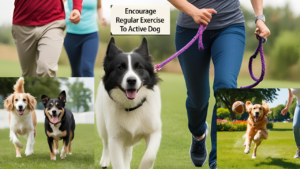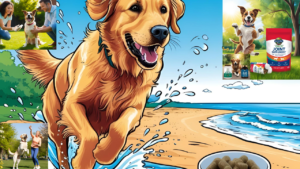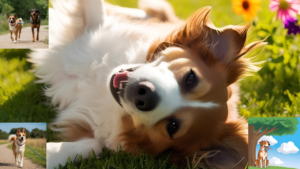Healthy joints in active dogs: Feed a Nutritious Diet

Nutrition is also understood to play a crucial role in functioning of joints. Feed the dogs with quality food that meets the nutritive requirements of rich value. It is advised to consume foods high in Omega-3 fatty acids, glucosamine and chondroitin. These nutrients make the joint flexible hence enhancing movements while at the same time inhibiting inflammation.
Avoid overfeeding. Obesity likewise exerts pressure on the articulations which leads to arthritis. These nutritional disorders can cause your dog to gain unhealthy weights, but you should restrict it by feeding the dog in portions.
Healthy joints in active dogs: Encourage Regular Exercise

Physical activity tones up muscles surrounding the joints base. These could include; swimming, walking on areas that have soft surfaces or any activities that do no strain the joints. These exercise are suitable for the dog since they help in the build up of muscle tone without straining the joints.
They should not engage in activities that involve short lasting vigorous exercise sessions weekly. However, do not rush it and steadily work out until you can weekly go through all of these exercises. This can help to avoid inflammation and to preserve the tissues forming joints.
Healthy joints in active dogs: Provide Joint Supplements

It may also be important for the owner to feed the dog supplements containing glucosamine and chondroitin. Now there are key ingredients that are mostly used in the supplement that includes glucosamine, chondroitin, MSM etc. all these are used to improve the health of cartilage. Always you should consult with your veterinarian before you introduce any supplement into your dog’s diet.
Initiate a Friendly for Both Joint Parties ambiance

The life surroundings of a dog may influence the health of your dogs joints. Give them soft materials to lay on this will help in reducing stress on their joints when they’re resting. Make use of ramps or step to enable them get on furniture or in cars. This in turn reduce pressure on their hips and knee joints hence will not be easily develop grave injuries.
Keep floors non-slippery. Slippery surfaces may result in falls and this will cause some harm like muscle injuries. Additional use of rugs or mats to increase the rate of friction of the floor area.
Schedule Regular Vet Visits

In check-ups, doctors are able to diagnose joint related problems at their early stages. It is possible for the vet to check around your dogs’ sentient ability if not mobility and suggest on the treatment that is required. Early action helps to avoid development of complex issues out of simple problems.
Your vet may recommend breed-specific early detection tests for joints in large-breed or lab or German Shepard dogs, for cases where joint problems are likely.
Manage Pain and Inflammation

Hyperactivity is not uncommon and is usually accompanied by joint inflammations in dogs. Pay attention to your dog’s behaviour, particularly, when he is limping, stiff or unwilling to use his legs. If you see these signs, it is advised to visit your vet.
Your vet may recommend drugs to reduce inflammation or other options such as using a laser or physiotherapy to help your dog get comfortable.
Avoid Overexertion

While you should take your dog for a walk or jog, do not overexert your dog since this will have an effect on his joints. It is important also to keep off activities such as jumping up and down or running on a concrete floor. After engaging in a physically active session, your dog needs to be made to rest.
Support Aging Joints

With age, the joint becomes vulnerable and would require proper care. They require moderate activities, need to be on a special diet, and should be supplemented with joint formulas. Additions of orthopedic beds and ramps must also be given to those patients in need.
When you want to observe your aging dog closely, you have to monitor their mobility levels. There are early symptoms that they may require joint help; they might be slow in rising or lagging behind a bit.
However, to keep your active dog’s joints in optimal health, you need to have a blend of diet and exercise plus some measures of proactive care. As per these tips, you can keep your pet in a healthy mood and avoid such problems which cause the pain in the dogs. Keep it in mind, a sound body produces a sound mind!
What are the best supplements for my dog’s joint health?
The best supplements include glucosamine, chondroitin, MSM, omega-3 fatty acids, and turmeric to support cartilage and reduce inflammation.
How can I prevent joint issues in my active dog?
Maintain a healthy weight, provide joint-friendly exercise, use supplements, and ensure proper nutrition to prevent joint strain and degeneration.
What are low-impact exercises for dogs with joint concerns?
Swimming, leash walks on soft surfaces, and controlled strength exercises like hill walking are great for reducing joint stress.
Can a dog’s diet affect joint health?
Yes! A balanced diet with omega-3s, lean proteins, and antioxidants helps maintain healthy joints and reduce inflammation.
How do I know if my dog has joint problems?
Signs include limping, stiffness, difficulty standing up, reluctance to jump, and reduced activity levels. Consult a vet if you notice these symptoms.
What environmental changes can help protect my dog's joints?
Providing a soft bed, ramps instead of stairs, and avoiding slippery floors can minimize joint stress and discomfort.
